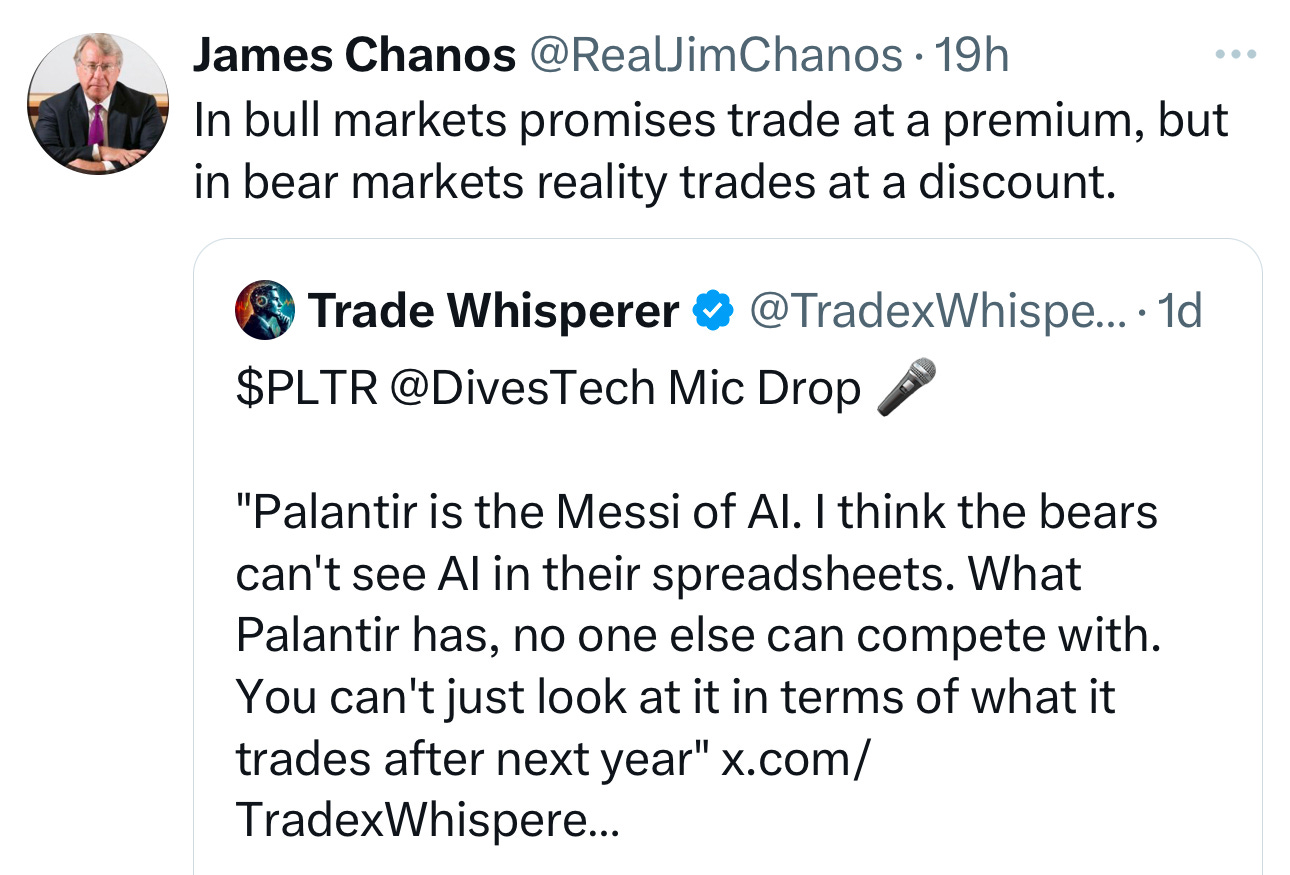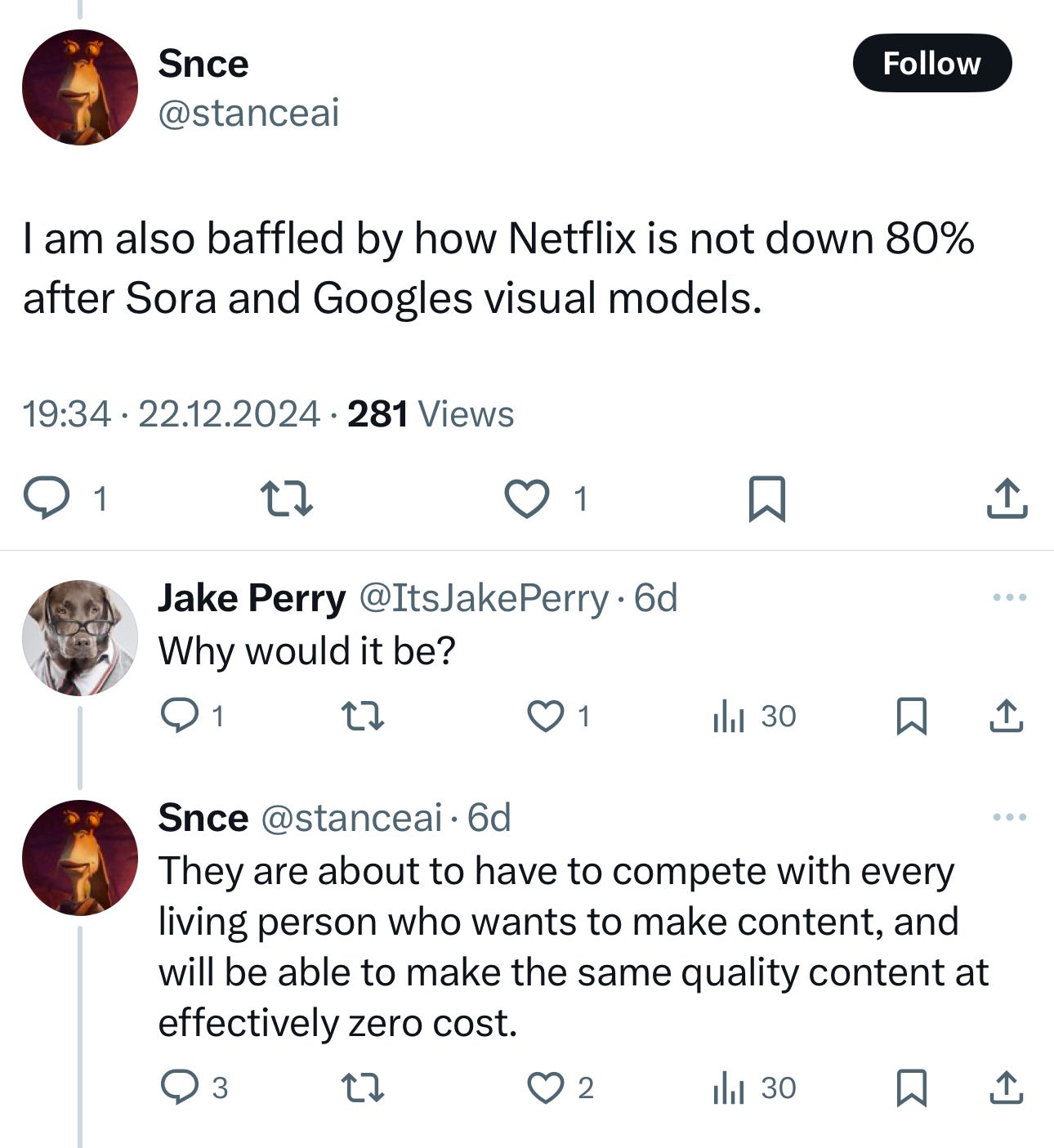Artificial Intelligence Long-Short Setup (probably not what you think)
*Not* a Sweeping Treatise on the Impact of AI
I recently had a bit of an epiphany — you might call it delusion:
That is what this post is about. It is not investment advice. Do your own work.
It does feel overwhelming to write about the impact of AI on stock returns, at least in a way that is actionable by investors. In some respects stock prices are already speaking loudly. The price performance of Nvidia, Palantir, and Tesla says volumes about the value creation potential of AI. These companies, and numerous others, are the obvious beneficiaries. Few would argue to the contrary on the fundamentals; any quibbles tend to focus on the likely winners’ stratospheric market quotations:
I will not try to add value here by opining on the market appraisals of Nvidia, Palantir, or Tesla. I’ll let the market decide what multiples it wants to put on these likely AI winners. That said, there are some ways to think about AI winners’ risk-reward tradeoffs. Otherwise, no difference would seemingly exist between investing $1,000 in Nvidia at 1x or 10x the recent market quotation. I explain my thinking in a broader essay entitled, “Why Inversion is Indispensable for Long-Term Success”.
The Bearish Side of the Coin
Today I focus on the fact that we haven’t really seen Mr. Market price in the flipside of AI — the creative destruction that may be about to wreck the business models of a range of public companies. Call it a feature of the long-running bull market: Investors are much more inclined to look for the winners than the losers. Not only that, but even when staring a likely loser in the face, investors seem willing to accept the loser’s narrative about AI being more of an opportunity than a threat.
In the very short term, the losers may be able to throw some AI bells and whistles on top of their legacy products and charge customers an extra fee, thereby boosting short-term results. Investors would be shrewd not to get lulled into complacency or the belief that a loser may actually be a winner. Instead, the short-term bump may be an opportunity to monetize winnings or even reverse the direction of a trade.
Sometimes investors get too deep into the weeds of a company, a situation, or a theme. Industry insiders are often the last to see the writing on the wall. Think Angelo Mozilo or bank analysts in 2007 (“real estate prices only go up”), or Blockbuster executives in the early days of Netflix (“picking a movie at the store is part of the experience”). Not seeing the forest for the trees applies here. Under such circumstances, we may need the perspective of a knowledgable outsider to push us to step back and consider the big picture.
Enter Adam D’Angelo, founder of Quora and AI startup Poe. Adam has a rich pedigree, having joined Facebook shortly after its launch and served as its chief technology officer. He was an investor in Instagram before its acquisition by Facebook. As a board member of OpenAI, Adam voted to remove Sam Altman as CEO. When Sam returned, the other three board members involved in the ouster resigned, but Adam retained his position.
Here’s his take from a couple of weeks ago:
Adam followed it up with this take:
One of the commenters was more explicit:
If you weren’t triggered before, you might be now: “There’s no way AI-generated movies or series can rival the best Hollywood releases. Humans will always prefer movies with real human actors instead of AI-generated characters. Netflix is a platform, so any quality AI productions will simply come onto the platform. Netflix has a massive scale advantage and can invest in AI ahead of its competitors. AI will expand the market, producing many winners, including Netflix.”
The list goes on, and the arguments put forth in favor of Netflix make sense. Yet, lurking beneath the surface is the uncomfortable truth that more supply — especially if it is near-unlimited, near-free supply — has to manifest somehow. Stark example: air — a highly valuable commodity, yet typically free due to near-unlimited supply.
A more mundane example: Groupon, the first mover and scale leader in online deals. Once supply exploded due to new entrants copying Groupon’s formula, the company had to accept an impairment to its business model, and the stock price followed.
Other examples abound in the business world. In hindsight, the argument is easy to comprehend. Looking ahead, though, our imagination usually fails us, especially if we have developed a positive association with an idea.
As an investor in Netflix, how could you not have a positive association with the company? It has been a massive source of good vibes, an example of the adage to let your winners run. You might be thinking, “I am not going to disregard this adage simply because an essay purports to know what might happen.” I don’t blame you.
In the case of Netflix, the most likely manifestation of the coming AI content explosion might be an impairment of the pricing power the company enjoys at the moment. The service can credibly claim that it adds more value than it costs, so demand is inelastic to price increases. Netflix has proven this point multiple times, and the stock price has acted accordingly. What happens if demand becomes more elastic to price in light of a sea of content alternatives, many of which may not only be low cost but also personalized and compelling?
In addition to Netflix, I would put the following companies in the category of incumbents who are likely to be hurt rather than helped by AI:
Other content owners, such as Paramount and Warner Bros Discovery
Recorded music owners, such as Universal Music Group
Gaming giants, such as Electronic Arts and Take-Two Interactive
Software incumbents, such as Salesforce, Adobe, and even HubSpot
I realize that the above examples are highly controversial, perhaps most of all Universal Music Group. Don’t get me wrong, music will continue to have value, but profitability should migrate toward live events and Spotify, in my humble view.
I won’t argue the specific examples above in detail, as such arguments tend to be futile in foresight. The market narrative and market-implied expectations are simply too optimistic and too powerful in light of the positive historical stock price performance of the companies listed above, with the stark exception of Paramount and Warner Bros Discovery. You might say that what the Internet did to PARA/WBD, AI may do to the other companies on the list. (I would not include PARA/WBD in a bearish trade — the valuations of both companies already reflect deep pessimism.)
Feel free to brush aside my opinion as that of a no-nothing when it comes to high-flying tech areas such as CRM and SaaS more broadly. But how do you brush aside Satya Nadella? In an appearance on the BG2 podcast a couple of weeks ago, the Microsoft CEO provided an outlook for B2B software that shocked many investors.
Check out the first four-and-a-half minutes:
Similarly, in a recent appearance on Bloomberg Technology, Klarna CEO Sebastian Siemiatkowski explained how AI is enabling his company not only to do away with expensive software — cutting out Salesforce and Workday — but also to freeze hiring, leading to a ~20% reduction in headcount annually.
The example of Klarna serves as a warning to investors in incumbents that stand to lose customers — or are forced to make major concessions — in the coming age of AI.
The Bullish Side of the Coin
Perhaps more importantly, Siemiatkowski provides a glimpse into the newfound ability of many companies to dramatically downsize their cost structure. This applies in particular to businesses that are heavy users of technology or, better yet, have large programming staffs.
The bullish setup: Imagine a company whose stock price has declined precipitously as the former highflyer has struggled to turn a profit. Investors have left the company for dead, resulting in a low multiple of enterprise value to revenue. A company that may have enjoyed a valuation of 20x sales or higher a few years ago may now sell for well under 1x sales.
A turnaround in profitability could produce multibagger upside, as sales remain mostly flat while the sales multiple expands due to strong profit growth. Any resumption in sales growth would add fuel to the fire, but the latter is not really needed, as the company already has a large base of sales relative to its recent enterprise value. The company needs margin expansion, which can be achieved through cost rationalization aided by AI.
A key requirement for any tech company I would consider seriously as part of this bullish setup is large insider ownership. I want management to be heavily incentivized to cut costs and grow shareholder value. Otherwise we could be stuck with a situation in which a CEO remains content to run the business near breakeven. I want a CEO who would be reaching into his own pocket if he desired to keep funding an unnecessarily bloated cost structure. Few owner-operator CEOs will do this, if the ability for dramatic cost cutting is staring them in the face thanks to AI.
Finally, I favor companies with strong balance sheets, i.e., a net cash position. This extends the runway and provides strategic flexbility. It also removes the risk of aggressive debt holders opportunistically forcing the company into a dilutive equity offering (or worse).
Behind the paywall, I list three companies that meet my bullish criteria. I believe these are winners of AI over the near- to medium-term. They have highly skewed risk-reward tradeoffs due to high insider ownership, strong balance sheets, large existing revenue bases relative to EV, and a massive margin expansion opportunity due to AI.
I am long all three companies. Not investment advice. Do your own work.
Drumroll please.








